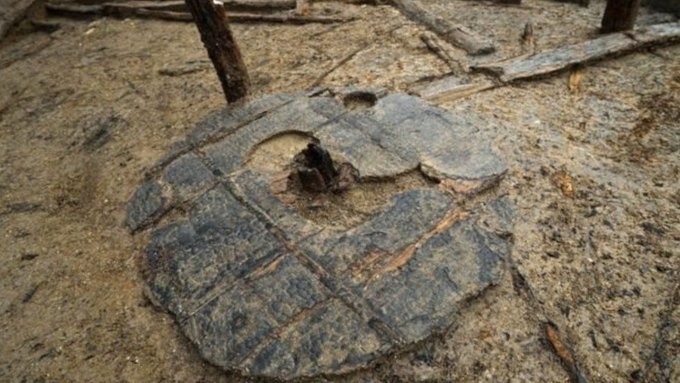Animal Husbandry in the Bronze Age
The start of the Bronze Age saw a significant move away from the grazing and cultivation of large open spaces. This was replaced by the ‘field systems’ of ditched boundaries and trackways. This would suggest that farming became more intensive with small communities making shelter and fenced fields to house cattle, sheep, goats and pigs.
The presence of substantial wheels of Bronze Age date, such as those found at Flag Fen (c. 1300 BC, approximately 800mm in diameter) and Must Farm, give us a high degree of certainty that animals were also being used for carting materials
The earliest complete wheel recovered in Britain, from Flag Fen
© Must Farm
Cattle
Although the remains of aurochs, the wild ancestor of cattle, have been found in Britain dating from the Mesolithic period, the domesticated cattle stock present in the Bronze Age, originated from populations on Continental Europe, probably from the Paris and Rhine Basins rather than through the domestication of these native aurochs. This suggests that most or all British Neolithic domestic cattle had to have been imported from Europe.
Cattle were believed to be of special value as they were a powerful steadfast companion in their use as draught animals. For this reason it is probable that they were kept for several years (due to the length of time it would have taken to train them to pull carts or ploughs). Small communities could have used cattle as a source of meat during feasting periods only, as they did not have the means to preserve the amount of meat one animal would produce, for long periods of time.
Sheep
The numerous bones found on many archaeological sites, show that flocks of sheep were kept throughout the Bronze Age. The first sheep introduced in the Neolithic period are believed to have had wool that was not suitable for weaving. Even in later periods, no fabric made from wool has been found in Britain, despite finds of spindle whorls and loom weights. Whilst these first sheep’s wool was no good, there is strong evidence that the sheep were used widely as a source of milk. Tests on pottery confirm that milk from both cattle and sheep was used from an early date.
A Manx Loaghtan sheep: a rare breed now, but similar sheep would have been present in Britain in the Bronze Age. You can see this breed of Sheep at Butser Ancient Farm.
Pigs
Few teeth have been found from pigs on most archaeological sites in Southern Britain, suggesting that they were not widely kept in Bronze Age villages. This could be due to the land not providing the right nutrients to support them. It is, therefore, believed that pigs were reared in small quantities and used for feasting, which was an important feature of communal life. They would have providing food on a lavish scale and this would have been used to show off an individual’s status in the community.
Horse
Domesticated horses were present in the Bronze Age from around 2,000 BC. They were relatively small by modern standards, which leads archaeologists to believe these ancient horses were too small to be ridden. They may have been used for driving and the Bronze Age horse trappings which have been found, including snaffle bits, suggest horses were harnessed to vehicles. Bronze Age cart wheels have been found at Flag Fen and Blair Drummond, the latter dating from around 1,255 – 815 BC which lends support to this theory (although these may have belonged to vehicles pulled by oxen).
Whilst hard evidence for Early Bronze Age horse-riding is lacking, bareback riding may have happened, involving materials which have not survived due to decomposition. Nevertheless, by the late Bronze Age we know, from excavation, that (larger) horses were ridden into battle in Britain. Whether these larger breeds of horses were developed in Britain or were imported from the continent is a moot point.
Dogs
In Britain, the Mesolithic dog is represented in archaeology by not more than four animal excavations, with each specimen being about 60 cm shoulder height. Later, in both the Neolithic and the Bronze Age, the available evidence indicates there was only a single ‘breed’ of dog and the remains show little variation. Dogs don’t appear to have been ‘Man’s best friend’ yet, with scavenging dogs probably being tolerated rather than bred. They did, however, defend territory shared with humans and some were easily trained as hunting and herding companions.
Chickens
There is little evidence to suggest chickens were kept as domesticated animals. The only remains of a domesticated hen were found in Prague, which is believed to be from towards the end of the Late Bronze Age.


